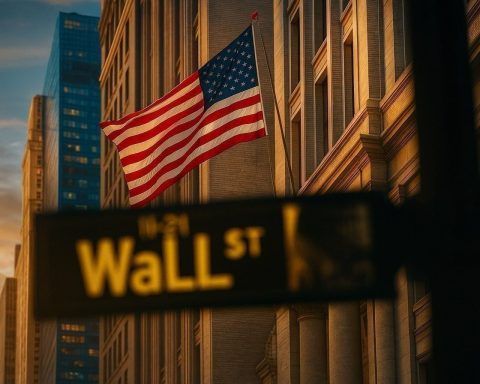The US stock market is staging a cautious rebound on Friday, November 21, 2025, as Wall Street digests a brutal tech‑driven selloff, a sharp crypto crash, and fresh signals from the Federal Reserve that a December rate cut is back on the table.
By late morning in New York, the Dow Jones Industrial Average was modestly higher, while the S&P 500 and Nasdaq swung between small gains and losses, leaving all three benchmarks still on track for their worst week since the spring of 2025. [1]
Wall Street Tries to Recover After a Wild Thursday
Thursday’s session set the tone for today. After an early surge powered by Nvidia’s blockbuster earnings and stronger‑than‑expected jobs data, stocks reversed violently as investors dumped high‑growth tech and AI names.
- The Dow closed Thursday down 0.8%, the S&P 500 fell 1.6%, and the Nasdaq tumbled 2.2%, its lowest close since early September. [2]
- The selloff was extreme: both the Nasdaq and Dow swung more than 1,000 points intraday, and the semiconductor index slid nearly 5%. [3]
- The Cboe Volatility Index (VIX) logged its highest close since April 24, signaling a sharp spike in fear. [4]
Friday opened on a better note. US stock futures climbed overnight, and the Dow, S&P 500 and Nasdaq all opened higher, supported by short‑covering and bargain hunting after two days of heavy losses. [5]
As of late morning ET:
- A Reuters snapshot showed the Dow up about 0.1%, the S&P 500 up roughly 0.3%, and the Nasdaq higher by around 0.2%. [6]
- Other real‑time trackers later showed the Dow up roughly 0.3–0.5%, while the S&P 500 flattened out and the Nasdaq slipped back into slightly negative territory, underscoring how fragile the rebound remains. [7]
For the week, the major benchmarks are still pointing lower, with the S&P 500 down more than 2% and the Nasdaq off around 3%. [8]
Fed’s John Williams Re‑Ignites December Rate‑Cut Bets
The biggest catalyst today isn’t a corporate earnings report or a data release—it’s a speech.
John Williams, President of the New York Federal Reserve and a key voting member of the FOMC, said in prepared remarks at a conference in Chile that there is “room for a further adjustment in the near term” to the federal funds rate—widely interpreted as support for another rate cut as soon as December. [9]
Markets immediately reacted:
- The CME FedWatch tool now shows roughly a 70–73% probability of a 25‑basis‑point rate cut in December, up from about 39–40% before Williams spoke. [10]
- Treasury yields fell again, with the 10‑year yield hovering just above 4.0%, easing financial conditions and lending support to rate‑sensitive stocks like housing and growth names. [11]
But the Fed story is far from one‑sided:
- Boston Fed President Susan Collins told CNBC that policy is “in the right place,” signaling skepticism about the need for another near‑term cut. [12]
- Fed officials remain split between cutting to support a cooling job market and holding rates to keep pressure on stubborn inflation, a debate that is feeding market volatility. [13]
Recent economic data haven’t clarified the picture much either:
- A delayed September jobs report showed nonfarm payrolls rising by 119,000 vs. about 50,000 expected, even as the unemployment rate ticked higher, complicating the Fed’s reading of the labor market. [14]
- A fresh business survey showed US factory activity slowing to a four‑month low, with tariffs pushing up input prices. [15]
Taken together, Friday’s bounce is as much about relief that the Fed might cushion the slowdown as it is about confidence in growth. That’s a fragile foundation—especially with markets already on edge.
AI and Big Tech: From Market Darlings to Main Risk
The AI trade that propelled US equities for much of 2025 is now at the center of the selloff.
On Thursday:
- Nvidia, the world’s most valuable company, reported blowout results and upbeat guidance, but its shares reversed from a 5% intraday gain to a 3.2% loss into the close. [16]
- An index of semiconductor stocks slid nearly 5%, and the broader tech sector was the S&P 500’s worst performer. [17]
Today, Nvidia and other AI‑linked names remain under pressure:
- Nvidia shares continued to trade lower in Friday’s session, even as many Wall Street analysts reiterated positive long‑term views and turned the pullback into a “buy‑the‑dip” call. [18]
- Several major cloud and cybersecurity stocks—including Oracle, AMD, Datadog and CrowdStrike—rank among the S&P 500’s biggest decliners, extending a two‑week de‑rating in high‑flying tech. [19]
Behind the moves is a growing sense that AI spending, valuations and corporate leverage may have run ahead of fundamentals:
- A recent global fund manager survey cited by Reuters shows more than half of respondents now view AI as a bubble, and nearly 45% see that bubble as the biggest tail risk heading into 2026. [20]
- Commentators at Bank of America and others have framed the week’s slump as putting “the bubbly on ice”—a vivid shorthand for the cooling of enthusiasm around AI and crypto‑adjacent assets. [21]
For now, the story of US stocks today is a tug‑of‑war between renewed hopes for cheaper money and mounting skepticism about the AI trade that led the market higher all year.
Crypto Crash Amplifies Risk‑Off Mood
If tech stocks are flashing “bubble risk,” Bitcoin and other cryptocurrencies are broadcasting full‑blown risk aversion.
Over the past several days:
- Bitcoin has dropped back into the mid‑$80,000s, hitting its lowest levels since April and erasing its 2025 gains. [22]
- The token is down roughly 8–12% for the week, depending on the snapshot, and more than 20% from its October peak above $120,000. [23]
- Ether and other major coins have also fallen sharply, with some reports noting 10%+ declines in the last 24 hours amid a “liquidity crunch” in crypto markets. [24]
Risk appetite is clearly deteriorating:
- Crypto market coverage describes a wave of forced liquidations, ETF outflows and a plunge in “fear and greed” sentiment indexes to historic lows, with around $1 trillion or more in crypto market cap wiped out in recent weeks. [25]
This matters for stocks because:
- Crypto has become a barometer of speculative risk, especially around AI and “next‑gen” tech themes.
- Publicly traded companies with heavy Bitcoin exposure or crypto trading businesses have seen their shares pulled lower along with the coins. [26]
When AI high‑flyers and crypto move down together, broader equity volatility tends to spike—as Thursday’s wild intraday swings made clear. [27]
Big Stock Movers: Eli Lilly’s $1 Trillion Moment, Oracle’s Slide, Retail and Housing Names Pop
Even in a volatile tape, individual stories are cutting through the noise.
Eli Lilly Becomes the First $1 Trillion Drugmaker
In one of the day’s landmark milestones, Eli Lilly briefly crossed a $1 trillion market capitalization, becoming the first healthcare company to hit that threshold. [28]
- Lilly’s stock rose around 1–1.5% in today’s trade after surging more than 35% year‑to‑date, powered by blockbuster demand for its obesity and diabetes drugs Mounjaro and Zepbound. [29]
Oracle, Chip and Cloud Names Lead the Losers
At the other end of the leaderboard:
- Oracle is among the worst performers in the S&P 500, falling roughly 6–7% today and more than 40% from its September record high as investors reassess the pace and profitability of AI‑related cloud spending. [30]
- AMD, Datadog, Vistra and CrowdStrike are also down between 3–5%, extending the week’s broader derating of premium growth tech. [31]
Intuit, Ross, Gap and Homebuilders Shine
Not every growth story is under pressure:
- Intuit is trading 4–5% higher after posting strong quarterly results and guiding revenue in line with Street expectations, suggesting resilient demand for its financial software suite. [32]
- Retail names Gap, Ross Stores and Walmart are also outperforming:
- Gap is up about 4–5% after beating earnings and lifting sales and margin guidance. [33]
- Ross and Gap shares each gained roughly 5–7% following solid post‑close earnings yesterday. [34]
- Walmart, fresh off a 6.5% surge on Thursday tied to strong results and a planned listing move to the Nasdaq, is ticking higher again. [35]
- Homebuilder stocks such as DR Horton and Lennar are among today’s notable gainers, with mid‑single‑digit percentage increases as falling bond yields revive interest in housing‑related trades. [36]
Sector Check: Defensive Plays vs. Growth Darlings
Under the surface, today’s action continues the rotation away from high‑multiple tech and into more defensive or rate‑sensitive areas:
- For the week, information technology and consumer discretionary are among the worst‑performing sectors in the S&P 500, reflecting the pressure on AI, cloud and consumer‑facing growth names. [37]
- Consumer staples and select healthcare stocks have fared better, with staples even managing to be the only S&P 500 sector in the green on Thursday’s rout. [38]
- The crypto‑linked and speculative tech complex continues to underperform, in line with the sharp drawdown in Bitcoin and Ether. [39]
The pattern is typical of late‑cycle markets:
- Rate‑cut hopes lift the broader indices and rate‑sensitive names, like housing and some credit‑exposed financials. [40]
- Investors trim exposure to the most crowded trades, especially AI winners and crypto‑adjacent stocks, where valuations are richest and positioning heaviest. [41]
What Today Means for Investors Watching the US Market
A few themes are emerging from today’s US stock market action (November 21, 2025):
- Volatility Is Back in Force
- The combination of swingy intraday moves, elevated VIX and sharp reversals suggests that algorithmic flows, options positioning and macro headlines are driving short‑term price action more than fundamentals. [42]
- The Fed Is in the Driver’s Seat Again
- John Williams’ comments have meaningfully shifted expectations toward a December rate cut, even as other officials push back. Markets are likely to react sharply to every speech, data point and hint ahead of the December FOMC meeting. [43]
- AI and Crypto Are Moving from Tailwind to Risk Factor
- After an extraordinary run, AI‑linked megacaps and crypto appear to be in a valuation “reset” phase, where even very good news (like Nvidia’s earnings beat) isn’t enough to keep prices elevated. [44]
- Defense and Quality Are Back in Fashion
- The outperformance of healthcare giants like Eli Lilly, stable retailers and homebuilders—alongside weakness in speculative tech—underscores a shift toward quality earnings, cash flow and pricing power. [45]
For readers tracking markets via Google News or Discover, the takeaway is straightforward:
- Today’s bounce is real but tentative. A single dovish signal from the Fed has been enough to stabilize stocks—for now—but underlying concerns about AI valuations, leverage, and the health of the job market remain unresolved.
- The December Fed decision, plus upcoming inflation, jobs and manufacturing data, will likely determine whether this week’s drop proves to be a normal correction in a longer bull market or the opening chapter of a more prolonged downturn. [46]
This article is for informational purposes only and does not constitute investment advice. Markets move quickly; all index levels and price moves refer to conditions reported on November 21, 2025, and may have changed since the latest data cited above.
References
1. www.reuters.com, 2. www.reuters.com, 3. www.reuters.com, 4. www.reuters.com, 5. www.reuters.com, 6. www.reuters.com, 7. www.investopedia.com, 8. m.economictimes.com, 9. www.newyorkfed.org, 10. www.investopedia.com, 11. www.investopedia.com, 12. www.reuters.com, 13. www.investopedia.com, 14. www.reuters.com, 15. www.reuters.com, 16. www.reuters.com, 17. www.reuters.com, 18. www.barrons.com, 19. 247wallst.com, 20. www.reuters.com, 21. fortune.com, 22. www.investopedia.com, 23. www.reuters.com, 24. www.coindesk.com, 25. www.reuters.com, 26. www.reuters.com, 27. www.reuters.com, 28. www.investopedia.com, 29. www.investopedia.com, 30. www.investopedia.com, 31. 247wallst.com, 32. www.reuters.com, 33. 247wallst.com, 34. www.investopedia.com, 35. www.reuters.com, 36. 247wallst.com, 37. www.reuters.com, 38. www.reuters.com, 39. www.reuters.com, 40. www.reuters.com, 41. www.reuters.com, 42. www.reuters.com, 43. www.newyorkfed.org, 44. www.reuters.com, 45. www.investopedia.com, 46. www.investopedia.com










